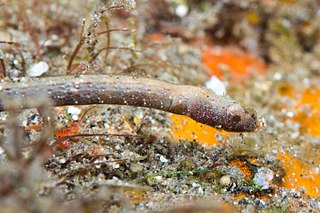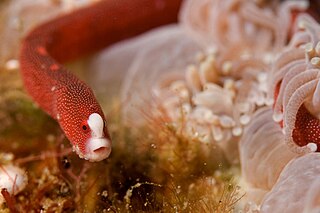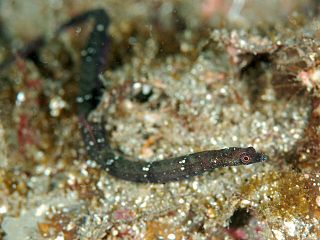
Syngnathus is a genus of fish in the family Syngnathidae found in marine, brackish and sometimes fresh waters of the Atlantic, Indian and Pacific Ocean. Fossils of these species are found from the Oligocene to the Pleistocene. They are known from various localities of Greece, Italy, Germany and United States.

The greater pipefish is a pipefish of the family Syngnathidae. It is a seawater fish and the type species of the genus Syngnathus.

The estuarine pipefish or river pipefish is a species of fish in the family Syngnathidae. It is endemic to South Africa and has been sporadically recorded in the estuarine portions of the Kariega, Kasouga, Bushmans, East Kleinemonde and West Kleinemonde Rivers. It can be readily distinguished from another southern African pipefish with which it shares its habitat, S. temminckii, by its much shorter snout. The estuarine pipefish is most commonly found in beds of the eelgrass Zostera capensis. Although twice thought to be extinct, recent surveys have found juvenile Estuarine Pipefish in areas where it had not been reported in over four decades.

The messmate pipefish is a species of marine fish in the family Syngnathidae. It is widespread throughout the tropical waters of the Indo-Pacific region, from the eastern coast of Africa to the Vanuatu Islands. This species can reach a length of 19.8 cm. It occasionally makes its way into the aquarium trade where it is known as the dragonfaced pipefish. Other common names are bloodspot pipefish, reef pipefish, reeftop pipefish and yellow-streaked pipefish.
Pelagic pipefish, Syngnathus phlegon, is a pipefish species of the family Syngnathidae.
Choeroichthys is a genus of pipefishes of the family Syngnathidae native to the Indian and Pacific Oceans.

Halicampus dunckeri or also commonly known as the Duncker's pipefish or ridgenose pipefish is a species of fish in the family Syngnathidae.
Choeroichthys latispinosus, also known as the Muiron Island pipefish or Muiron pipefish, is a species of pipefish native to the western coast of Australia. Described by Charles Dawson based on a single specimen in 1978, the species is still known from only three localities.
Hippichthys cyanospilos, commonly known as the blue-spotted pipefish or bluespeckled pipefish, is a marine fish belonging to the family Syngnathidae, native from the Indo-Pacific area.

Bulbonaricus brauni is a species of marine fish of the family Syngnathidae. It is found in the Eastern Indian Ocean, from Indonesia to Western Australia, and off the Ryukyu Islands of Japan. It lives among coral reefs at depths of 1-10m, and can grow to lengths of 5.5 cm. This species is ovoviviparous, with the males carrying eggs in a brood pouch until they hatch. The specific name honours "the collector" Mr J. Braun who brought the living holotype to the Western Australia Museum.

Choeroichthys brachysoma is a species of marine fish of the family Syngnathidae. It is found in the Indo-Pacific, from the Red Sea and East Africa to the Society Islands, the Philippines, Guam, and northern Australia. It inhabits tide pools, seagrass, rocky coastlines, mangroves, and coral reef areas at depths of 2–25 metres (6.6–82.0 ft), where it can grow to lengths of 7 centimetres (2.8 in). C. brachysoma shows sexual dimorphism, the females are slender with two rows of black spots along their flanks, while the males have a shorter, wider body marked with scattered, small white spots. This species is ovoviviparous, with males carrying eggs in a brood pouch until giving birth to live young. Males may brood at 3.5–4 centimetres (1.4–1.6 in).
Choeroichthys sculptus, the sculptured pipefish, is a species of marine fish of the family Syngnathidae.
Choeroichthys suillus is a species of marine fish of the family Syngnathidae. It is endemic to Australia, occurring from Perth, along northern Australia, to southern Queensland. It lives in coral reefs to a depth of 14 metres (46 ft), where it can grow to lengths of 6 centimetres (2.4 in). This species is ovoviviparous, with males carrying eggs and giving birth to live young. Within the reef it is found among coral rubble.
Nannocampus elegans, the elegant pipefish, is a species of pipefish native to the Western Indian Ocean.
Dunckerocampus chapmani is a species of marine fish of the family Syngnathidae. It is endemic to New Caledonia, where it inhabits shallow lagoons to depths of 0–8 metres (0–26 ft). It has only been recorded in the vicinity of the city of Noumea. It can grow to lengths of 8.5 centimetres (3.3 in). It is expected to feed on small parasitic crustaceans that grow on other fishes, similar to most other members of its genus. This species is ovoviviparous, with males carrying eggs and giving birth to live young. The eggs of D. chapmani are particularly large, meaning that only 30 per brood are produced, which is quite low for a pipefish. Males may brood at 8 centimetres (3.1 in).

Dunckerocampus multiannulatus is a species of marine fish of the family Syngnathidae. It is widespread in the Indian Ocean, from the Red Sea and South Africa to the Andaman Islands and Sumatra, Indonesia. It inhabits coral and rocky reefs to depths of 45 metres (148 ft), where it can grow to lengths of 18 centimetres (7.1 in). It is an active cleaner, feeding on small crustaceans that grow on other fishes. This species is ovoviviparous, with males carrying eggs and giving birth to live young. Males may brood at 13 centimetres (5.1 in).

Booth's pipefish is a species of marine fish of the family Syngnathidae. It is found in the Western Indian Ocean, in South Africa and the Comoro Islands, and in the Western Pacific, from South Korea and Japan to the Great Barrier Reef and Tonga. It lives in rocks and coral reefs to depths of 30 metres (98 ft), where it can grow to lengths of 17.5 centimetres (6.9 in). This species is ovoviviparous, with males carrying eggs and giving birth to live young. The specific name honours for Julie Booth, who "presented many interesting fishes to the Australian Museum from New South Wales and Lord Howe Island".
Hippichthys spicifer, commonly known as bellybarred pipefish, banded freshwater pipefish, or blue spotted pipefish, is a species of pipefish of the family Syngnathidae. It is found in the Indo-Pacific, from the Red Sea and East Africa to Sri Lanka and Samoa. It lives in shallow coastal and estuarine habitats such as mangroves, tidal creeks, and the lower reaches of rivers, where it can grow to lengths of 18 centimetres (7.1 in). It is expected to feed on small crustaceans and mosquito larvae. This species is ovoviviparous, with males brooding eggs in a brood pouch before giving birth to live young. It is reproductively active all year, with males and females reaching sexual maturity at 10.8 and 10 centimetres respectively. Brood size can vary significantly, from 114 to 1764, with an average of 604.4 plus or minus 322.8.
Lissocampus bannwarthi is a species of marine pipefish belonging to the family Syngnathidae.
Stigmatopora nigra, also known as the wide-bodied pipefish is a species of marine fish belonging to the family Syngnathidae. This species can be found in the shallow waters, bays, and estuaries of southern Australia from Shark Bay to Brisbane, Tasmania, and New Zealand. They often inhabit seagrass or algae beds in addition to bare sand. Their diet consists of small crustaceans such as copepods and amphipods. Adult brooding males have been measured at 6.5-7 centimeters. Reproduction occurs through ovoviviparity. in which the males brood up to 25 eggs in a pouch below the tail before giving live birth. Stigmatopora nigra can live to 150 days old and are able to reproduce throughout the year.








